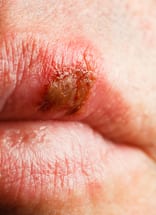Cold Sores
 Cold sores, also known as fever blisters, are among the most common oral lesions, occurring on the lips or around the mouth. These sores, which are often painful, are caused by the herpes simplex virus. There are two types of herpes simplex virus, HSV-1 and HSV-2. Cold sores are usually caused by HSV-1, while HSV-2 is usually the cause of genital herpes.
Cold sores, also known as fever blisters, are among the most common oral lesions, occurring on the lips or around the mouth. These sores, which are often painful, are caused by the herpes simplex virus. There are two types of herpes simplex virus, HSV-1 and HSV-2. Cold sores are usually caused by HSV-1, while HSV-2 is usually the cause of genital herpes.
The same virus that causes cold sores may also result in other symptoms, including fever, sore throat and swollen glands. Cold sores are normally diagnosed through physical examination alone, unless the physician suspects another variety of lesion.
Cold sores are highly contagious. Usually, the herpes virus affects the body when infected fluid enters a break in the skin. This typically happens through saliva contact, either through kissing or the use of shared eating utensils. Once an individual is infected, the virus can spread to other parts of the body. It is also possible for a person to have the herpes virus without visible cold sores.
There is no cure for cold sores, but they frequently go away after a few days without treatment. If a cold sore opens, lymph, a clear fluid, may drain from it. The cold sore will then typically form a scab. The cold sore scab normally heals within a few days to 2 weeks. Once an individual has contracted the virus, however it remains in the body and may precipitate subsequent outbreaks.
Outbreaks of cold sores tend to happen when the immune system is weakened: during or after an illness, during menstruation, or when an individual is under great stress. There are several topical treatment options available over-the-counter to hasten healing and lessen pain.
